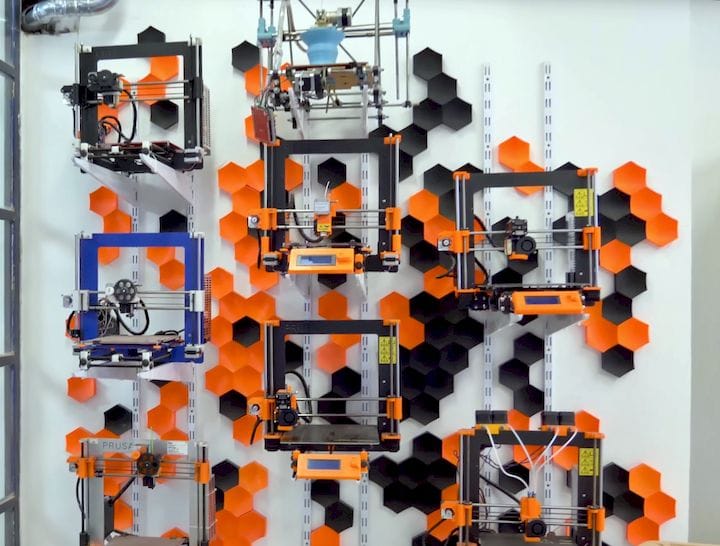![Prusa Research’s all-time product line on display at their HQ, including the current Original Prusa i3 MK3 printer [Source: YouTube]](https://fabbaloo.com/wp-content/uploads/2020/05/image-asset_img_5eb094a3bff4f.jpg)
Prusa Research has now officially sold more than 100,000 desktop 3D printers, mostly the Prusa i3 printer.
The Czech company celebrated their significant milestone with the release of a 27-minute video exploring their journey from start to today.
One hundred thousand 3D printers is an enormous amount of equipment. To put this in perspective, if we were to take an average price of, say, US$600 for their unit sales, this represents US$60M in revenue. Sixty million dollars! That figure is likely low, as their more recent machines, of which they’ve sold many more, have slightly higher unit prices. And their rate of sales continues every month; they say they are actually over 130K machines at this point, powered mainly by their flagship device, the Prusa i3, and in particular their most recent device, the Prusa i3 MK3. It’s conceivable they may have even topped US$100M in revenue.
These figures are staggering for a desktop 3D printer company. Over the years I’ve seen many startups attempt to parlay their uniqueness into high-volume success, but only a very few have made it, and none as spectacularly as Prusa Research.
Printing With The Prusa i3 MK3
Incredibly, the company started out by selling hardware components, but over the years has branched into a number of different categories of 3D printing, now all using their brand “Original Prusa”. Over time they added not only 3D printers but also added features, such as auto calibration, and most recently their MMU upgrade, which can enable multi-material 3D printer or even spot color 3D printing. Worldwide, their 3D printers are used to build countless objects.
Their celebratory video is quite interesting to watch:
Multiple Steps Enable Prusa Success
As someone who is close to the startup scene, many features of Prusa’s journey resonate with me:
-
Innovation driven by need
-
Accidental discovery of a viable business
-
Rapid expansion
-
Bold moves
-
Mistakes and learning
-
Strong branding
-
Ongoing focus on clients and their needs
It’s the classic case of a startup success journey, and others wishing to emulate the same goal should take some lessons from this highly successful company.
![Prusa Research’s original shipping method: pizza boxes [Source: YouTube]](https://fabbaloo.com/wp-content/uploads/2020/05/image-asset_img_5eb094a425f42.jpg)
A New Category of Desktop 3D Printing Success
Reaching 100,000+ 3D printers in the field took Prusa Research several years to achieve, but their next 100,000 could happen in a far shorter time, as their expanded factories enable much more production. We don’t know their current production rate, but it’s quite possible they’re producing in excess of 6,000 machines per month. That implies they’ll hit 200,000 machines shipped in little over a year, assuming their growth rate persists. There will be people in all categories printing with their Original Prusa printers.
![Shipping new desktop 3D printers from Prusa Research [Source: YouTube]](https://fabbaloo.com/wp-content/uploads/2020/05/image-asset_img_5eb094a467573.jpg)
But that growth rate could be the next challenge for Prusa Research. There could be a couple of bumps they must overcome.
Challenges For The Original Prusa i3 MK3
First, they must continue to maintain machine quality and functionality. As time passes there will be new offerings from competitors that, eventually, will match Prusa Research’s combination of ease of use, quality, reliability and price.
Prusa Research will no doubt have to eventually release a “MK4” device with even more advanced features to maintain their growth. I don’t know what features they may include in such a machine, but I’m hoping they focus on ease-of-use features rather than adding new capabilities already seen in other devices like a second extruder, etc.
A second and perhaps more difficult challenge for Prusa Research will be the size of the market. While they’ve sold 100,000 devices, is it reasonable to expect there to be buyers for 200,000 machines? A million machines? Ten million?
The problem here is that although Prusa Research has made significant advances in reliability and quality, desktop 3D printers are still challenging for the general public to operate. That means there is a finite number of potential buyers — and I’m wondering if the majority of them already own a capable 3D printer. How many more customers can there be?
Prusa 3D Printer Array Product?
![Prusa Research’s current 3D printer farm, used for manufacturing their own parts [Source: YouTube]](https://fabbaloo.com/wp-content/uploads/2020/05/image-asset_img_5eb094a4a9ccf.jpg)
One avenue Prusa Research might pursue to maintain growth could be to organize sales of arrays of machines. This would be for clients requiring higher levels of production by 3D printing in parallel in massive ways. Prusa Research already operates a massive 3D printer farm at their manufacturing site, including sophisticated software for management. They know a lot about this aspect, so why not package it up into a product?
A Prusa array 3D printer product would be quite interesting not only for clients, but also for Prusa Research, as their sales could be simplified: one sale to an institution could result in hundreds of machines shipped. More units per sale.
However, in the long term Prusa Research faces the same challenge as everyone else in the desktop 3D printer space: how to persuade the massive consumer market to buy machines. This was attempted years ago by others, but unsuccessfully. The problem was, and still is, that desktop 3D printers are still far too complex for the average person to use. Even worse, there are no obvious use cases for consumers to need them.
If Prusa Research can solve these issues, they will grow even more than they already have. They are hard challenges, but it seems they’ve already overcome several in the past; maybe they can do more.
Via Prusa Research











The fate of major 3D printing conferences in 2020 is unclear with the ongoing virus outbreak. We have thoughts on what it could mean.